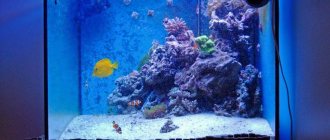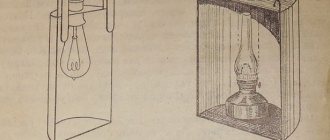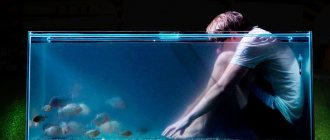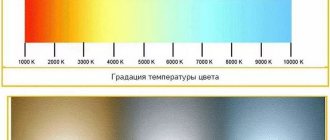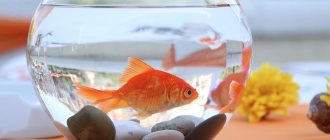After purchasing their first tank, newbies wonder whether they should turn off the lights in the aquarium at night. Of course, fish, shellfish, shrimp and plants, like other living creatures, require light, but they require it in a certain amount. In this case, it is necessary to take into account the fact that the duration of operation of lighting devices depends on the phenotypes and types of flora living there.
The role of lighting
In order to find out whether it is necessary to turn off the light in the aquarium at night, it is important to find out its role for aquatic inhabitants. Light is necessary for the normal development of fish and vegetation in the container. Under natural conditions, pets swim on the surface of the water, where the sun's rays penetrate. At home, there may not be enough sunlight, and aquatic inhabitants begin to lose their color. Therefore, it is important to use additional special devices. However, fish do not need light during the day. Turning off appliances allows them to remain in a state of rest. An exception may be some species of fish that search for food at night.
Do fish need light at night?
At night, lighting fixtures must be turned off. The only exception is when the container is located in a dark place where the sun's rays do not penetrate. In this case, it is necessary to use a lighting device during the daytime and leave a night light on at night.
LED lamps can also be used, which act as part of the decor and illuminate the container at night, giving it the necessary tone.
Top 8 Best Aquarium Lamps
Best Metal Halide Fluorescent Bulbs for Aquarium
BLV HIT 250W cw 10000K
These lamps are for advanced aquarists. Their cost is from 4000 rubles. For this money you will get a lamp with a power of as much as 250 watts, designed for large professional aquariums. The lamp has an aluminum-coated reflector built into it: thanks to it, the light from the lamp is distributed evenly, and the lamp does not heat the environment too much. This lamp is quite easy to change - it is mounted on an E40 socket. The manufacturer promises continuous operation for up to 8000 hours.
Price: RUB 4,069
BLV RX7S 150W 5200K
Lamp BLV RX7S 150W 5200K - costs from 600 rubles. 150 watt gas discharge lamp for RX7S socket. Consistently produces bright daylight white light with a color temperature of 5200 Kelvin, which will remain unchanged throughout the life of the lamp. Durable, energy efficient, resistant to temperature changes. Does not have a destructive effect on plastic and dyed fabrics.
Price: ₽ 600
Best T5 Fluorescent Tubes
Aquatlantis Lighting fixtures T5
Fluorescent lamp for fish Aquatlantis T5 lighting fixtures for Evasion Horizon 150 aquariums. It will serve as a backlight for a long time. Designed for 150 series aquariums from Evasion Horizon, but can be used with other aquariums of a similar configuration. Installed in classic lamps from the Portuguese company Aquatlantis: with long metal bodies that are attached to plastic mounts directly on the walls or aquarium lids. This lamp is characterized by high quality, efficiency and long service life.
Price: RUB 24,339
Jebo 8W T5
Jebo aquarium lamp white 8W T5 costing from 550 rubles. Reliable lamp in an oblong shaped body. Made in three different colors: white, blue and red - for different types of aquariums with different inhabitants. The high luminous efficiency and long service life of this lamp are confirmed by the observations of numerous fans. There are also higher power versions: 10, 15, 20, 25, 30 and 40 watts.
Price: ₽ 545
Best LED Aquarium Lights
ADVANCE 40, AQUA TRESOR
The LED lamp, which shines brightly and hardly heats up, is characterized by high luminous efficiency and efficiency. A universal device that will suit any aquarium and will promote the growth of fish and photosynthesis of plants. Does not affect the quality of water in the aquarium and is completely safe for its inhabitants. The power of the lamps varies from 2.4 to 10 watts - you can choose the one that suits the size of your aquarium. The cost of the model starts from 3000 rubles.
Price: RUB 3,116
LEDDY SMART LED II SUNNY 6W
This aquarium lighting module is somewhat cheaper - it costs around 2000 rubles. The lamp is attached to the wall of an aquarium up to 6 millimeters thick and is perfect for small aquariums in the range of 10-50 liters and no higher than 35 centimeters. Able to work for about 10 years without any difficulties - all thanks to cold and economical LEDs housed in a thin and even elegant body. The color tends to be warm - the color temperature is 6500 Kelvin. Provides fish and plants with the necessary light and emphasizes their natural beauty.
Price: ₽ 2,001
Best T8 Fluorescent Tubes
Xilong Lamp T8 10W XL-50B
Fluorescent lamp for fish Xilong Lamp T8 10W XL-50B costs about 1,500 rubles. Designed for a lamp with one lamp, which is installed above an aquarium without a cover. The length of the aquarium should not exceed 50 centimeters: within this limit, the width of the lamp mounts can be adjusted. The lamp is equipped with a reflector and protected from splashes by plexiglass, looks stylish, and is also equipped with an additional socket - you can connect other aquarium equipment. Lamp power 10 W.
Price: ₽ 1,430
T8 15W 43.8cm Sylvania GROLUX
Aquarium lamp T8 15W 43.8cm Sylvania GROLUX costing from 500 rubles. This fluorescent lamp is designed for freshwater aquariums where there are plants that do not get enough daylight. Plants require photosynthesis to grow and develop, and to facilitate this process, the spectrum of the lamp is shifted towards blue and red radiation. Moreover, in the light of this lamp, plants and fish will not only grow better and feel good, but also look much better, because it emphasizes their natural colors. This lamp can illuminate not only aquariums, but also, for example, greenhouse or indoor plants.
Price: ₽ 530
Possible problems if you leave the lights on
Light in an aquarium at night can cause not only benefits, but also harm. These problems include:
- light in the aquarium at night leads to the rapid growth of algae on all decorative objects;
- pets sleep at night. Lack of sleep can lead to death. Since they become lethargic and stop eating food;
- Under natural conditions, day gives way to night. Therefore, in the absence of necessary living conditions, many fish may die;
- lamps at night can provoke aggression in aquatic inhabitants. As a result, the fish begin to attack other inhabitants.
Controlling the lamps at night will make living conditions more natural.
Which lamps are best to use for an aquarium?
For quite a long time, aquariums were illuminated with ordinary incandescent lamps, better known as Ilyich bulbs. It seems unfashionable to use them today, when technology has gone far ahead. But if you look at them from the perspective of the quality of the light received, a completely different picture emerges. Yes, incandescent lamps have low efficiency, produce too much heat and not enough light. Yes, their service life is scanty, no more than 1000 hours. However, such lamps have a very valuable quality, this is the light emission spectrum, which practically coincides with sunlight.
Fluorescent lamps are also a good (energy efficient, inexpensive) light source. The service life of such lamps is much longer than that of incandescent lamps - 8,000-10,000 hours. However, the spectrum of LL is not wide enough.
However, you should not immediately abandon such lamps. In the LL family there are special lamps for lighting plants, for example, Osram L 15 W/77. Such lamps have improved spectral characteristics and can be used to illuminate both plants in general and aquariums in particular.
Halogen and metal halide lamps, panels and spotlights are also not recommended for lighting. They can only be used at a relatively large distance from the water (about 30 cm), which is why it will be necessary to construct special hangers or stands for such elements.
The best option is to illuminate the aquarium with LED lamps (LED lighting). This convenient way of supplying light allows you to create illumination as close as possible to natural light. At the same time, LEDs emit virtually no heat, so they can be positioned in any convenient way. It is also worth noting the long service life, which is several times greater than the operational “capabilities” of other lamps.
Another plus in favor of the fact that it is better to use LED lighting for an aquarium is the ability to adjust the brightness and a variety of lighting colors, which will give the decorative aquarium beautiful shades.
How to choose the right lighting
When asked whether it is possible to turn off lighting devices, you must say with confidence that yes. However, some criteria should be taken into account:
- fish requirements. Some fish prefer a lot of light. Other inhabitants spend most of their time in the shade. Therefore, before moving in, you should clarify this information;
- presence of algae. Vegetation in a container requires lighting at least 14 hours a day. Otherwise, the plants become weak and grow slowly;
- device type. Some lighting devices tend to heat the liquid. This can negatively affect the condition of aquatic life. Therefore, it is necessary to switch off at night;
- capacity volume and lamp power. Powerful devices can illuminate the entire container. Therefore, it is recommended to reduce the period of use of lighting so that the fish do not lose their bright color. Medium-power lamps are left on for a longer period.
Often, experienced aquarists use lighting devices with a special timer. A time is set that will bring the artificial living conditions closer to natural ones, and the device independently determines the operating mode.
Backlight intensity and brightness
Now let's touch on the issue of intensity and brightness of lighting. How to choose the right power and number of lamps of different designs, from simple or fluorescent to LED, is discussed in detail in the article below.
Briefly in terms of brightness, we can say that for a slow herbalist, 40 lumens are enough for each liter of water in the container. For a forced herbalist - 60 Lm/liter.
Once you have chosen the lamp you like and decided on its operating time, it is not recommended to turn it on at full power immediately. Plants need to get used to it.
Therefore, using a dimmer, you need to make sure that the light bulbs at the very beginning shine at a maximum of 2/3 of their peak. Continue this low light condition for about 1 week and watch the plants closely.
If everything is growing and developing normally, then you can add a little brightness and continue observing. If the front wall of the aquarium begins to quickly become overgrown and green, this is the first sign of an excess of light.
In this case, reduce the power by one step.
But what if you don’t have a dimmer and have nothing to artificially regulate the brightness and intensity of the lighting? In this case, you will have to gradually reduce the duration of daylight hours from the original calculated one.
There is another option - just raise the lamp a little higher.
Select the height experimentally based on the results of observations of the front wall. It shouldn't overgrow quickly.
Recommendations
It is necessary to turn off the lighting device. However, it is recommended to accustom aquatic inhabitants to a certain regime. To do this, you should follow these recommendations:
- The lamp should be turned on and off at the same time;
- At first, after turning off the main paw, it is necessary to leave the night illumination on. Since abruptly turning off the lamp will lead to restless behavior of aquatic inhabitants;
- in winter, reduce the length of daylight hours.
Following the recommendations will help keep your pets healthy and monitor algae growth.

